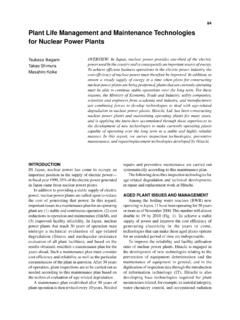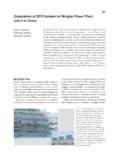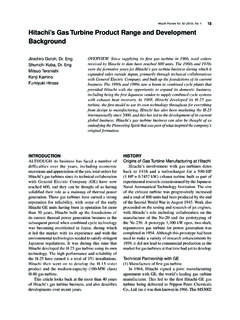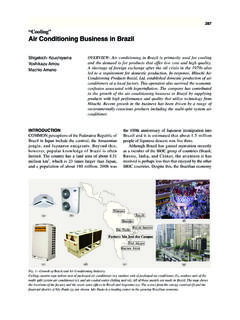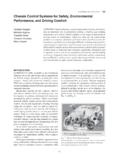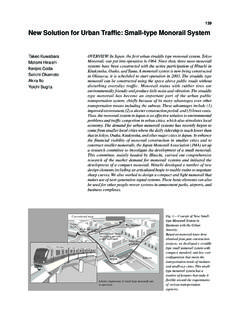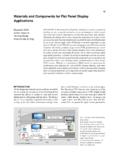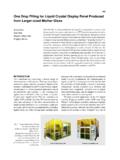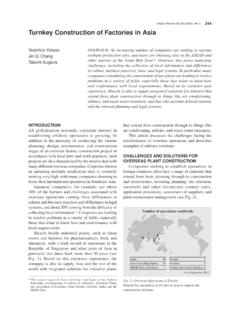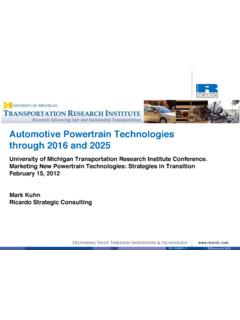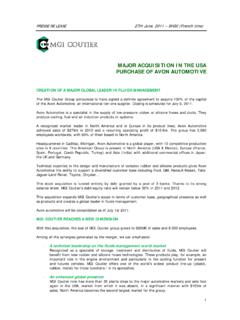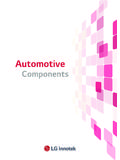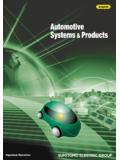Transcription of Reduction of CO2 Emissions for Automotive Systems
1 Reduction of CO2 Emissions for Automotive Systems 184 Reduction of CO2 Emissions for Automotive SystemsOVERVIEW: The amount of CO2 emission from the transport sector(including cars) accounts for about 20% of total CO2 Emissions . Accordingly,from the viewpoint of preventing global warming, reducing that proportionis a key issue. In regard to CO2 Emissions from cars, fuel economy standardsare getting tougher all over the world, so improving fuel economy of cars isstrongly desired. From now onwards, it is considered that fuel economy ofengines will be further improved by boosting engine efficiency and byhybridization (electrification) of cars. What s more, improving fuel economyby improving driving operation ( the operation in which a car is driven)and by smoothing traffic flows will come into the picture in the near these circumstances, with concern for the environment from theviewpoint of reducing CO2 and other exhaust Emissions , the Hitachi Groupis comprehensively promoting a broad range of technical developments forreducing CO2 Emissions from IshiiMinoru OsugaTakashi OkadaHideki MiyazakiMitsuru KosekiKoichiro TanikoshiINTRODUCTIONIN consideration of environmental problems, exhaustemission regulation and fuel economy standard ofpassenger cars and light trucks are being introducedon a global scale (for example, in Japan, Europe, andthe United States).
2 Although average fuel economy ofpassenger cars in Japan increased for a while duringthe bubble economy years around 1990, on thewhole, fuel economy of cars has continued to fall since1975. This trend was a result of the introduction ofelectronic control by microcomputers and weight-saving measures as well as introduction of technologieslike gasoline direct injection and variable valve timing;consequently, CO2 emission has been reducedconsiderably (see Fig. 1).As the number of cars on the road has grown,however, CO2 Emissions have increased, and effortsto reduce the amount of CO2 Emissions in countriesaround the world have intensified. For example, inJapan, new fuel-economy standards must be met by2015; in Europe, a target CO2 emission amount of 120g/km (corporate average) is set for 2012 and beyond;and in the United States, the new CAFE (CorporateAverage Fuel Economy) standard of the new energylegislation for passenger cars are now in , the first commitment period of the KyotoProtocol (which commits countries to reducinggreenhouse-effect gases like CO2) starts from 2008,and further reductions in CO2 emission will bestipulated from 2013.
3 In particular, the CO2 emissionamount from the transport sector (including cars) takesup 20% of total CO2 Emissions ; accordingly, carmanufacturers are facing significant challenges indeveloping technologies for reducing this portion oftotal CO2 thoughtful consideration to environmentalissues, particularly from the standpoint of reducingCO2 and exhaust Emissions , the Hitachi Group isengaged in development for fuel-efficient passengercars. As measures in the Automotive field, reductionof passenger-car CO2 Emissions by improving engineefficiency, promoting hybridization or electrificationof cars, and facilitating traffic flow by adopting ITS(intelligent transport Systems ) are commonly rest of this report describes the efforts ofHitachi aimed at reducing CO2 Emissions forautomotive Systems and our corresponding Reduction TECHNOLOGY FORENGINESA pproach for CO2 Reduction for GasolineEnginesTo reduce CO2 Emissions from cars, it is necessaryto improve their fuel economy.
4 This means extractingthe kinetic energy from the combustion energyHitachi Review Vol. 57 (2008), No. 5 185supplied to the car without any waste. The energy flowin a car is shown schematically in Fig. 2. To utilizeenergy efficiently, it is important to reduce loss in theengine and various accessories and to reduce resistancewhen the car is running while recovering heat energyand kinetic energy(1).As for Reduction of engine loss, attaining highcompression ratio and reducing pumping loss are regard to these approaches, at Hitachi, we arefocusing our efforts on direct-injection engine Systems (which inject fuel directly into the cylinders) andvariable-valve Systems (which lower pumping loss).Since direct-injection Systems inject fuel directly intothe cylinders, injection timing and fuel-air mixturedistribution in the cylinders can be controlled freely,and improved fuel economy and high power outputcan be obtained by attaining high compression , since the degree of control freedom is high,improvements to properties such as engine-knockresistance, lean burn, and large-scale EGR (exhaustFig.)
5 1 Trends Regarding CO2 Emission Reduction in Automotive 1975, as a result of weight-saving technology as well as various electronic engine-control technologiesand electrification technologies, fuel consumption per vehicle has decreased year on year. In consideration ofglobal environmental issues, global fuel-economy standards have been regularly strengthened, therequirement to reduce CO2 emission volume from vehicles has become tougher, and technologies for reducingCO2 emission have become more and more important. In the future, in addition to fuel-consumption reductionby applying high-efficiency engines (such as ones with gasoline direct injection, variable valve, and dieselengines), Reduction of CO2 emission volume through electrification (such as hybrid electric vehicles), ITSapplication and diversification of fuels will 2 Energy Flow Within an Automotive efficiently utilize energy, it is important to improve engineefficiency, reduce losses in various accessories, reduce dragwhile an Automotive vehicle is running, and recover heat andkinetic reductionAerodynamic characteristicsAluminum, magnesium, fiber-reinforced plastics.
6 Standard for US passenger carsEuropean CO2 regulation (corporate standard)Japan fuel-economy standardFirst commitment period (2008 2012) 2010 fuel-economy standard ( improvement compared to 1995)19801201401601802002202401990200020 102020 Carbu-retorElectrification of controlAirflow sensors, microprocessor controlBoosting engine efficiencyGasoline direct injectionDiesel Variable valvesHigh-efficiency enginesHomogeneous-charge compression ignitionHybrid electric vehicles (motor, inverter, battery)Auxiliary electrification (pumps, power steering)Ethanol fuel, bio-fuels, applicationElectrificationFuel diversificationBased on data from Japan Automobile Manufacturers Association, : 185 g/km (1995)Act on the RationalUse of Energy (1979)Kyoto Protocol (1997)2015 fuel-economy standard( improvement compared to 2004) mpg (1978)35 mpg (2020) mpg (1985)120 g/km (2012) (includingimprovement of tire performance and fuel)140 g/km (2008) (self-imposed regulation)Passenger car CO2 emission amount (g/km) in JapanCAFE: corporate average fuel economy ITS: intelligent transport Systems mpg.
7 Miles per gallon Post-Kyoto ProtocolEngineWeight savingMotorBatteryDrive-trainBrakesFuel energyEngine outputBraking energy[Corresponding technology]Brake horse powerTiresKinetic energyRunning resistance Weight-saving High-efficiency transmission Attaining lowauxiliary loss/ Electrification Attaining high compression ratio Variable valves Exhaust-heat recovery Idling stop (hybrid electric vehicle) Regenerative braking (hybrid vehicles)Drive-train loss Transmission, loss Oil pump, water pump, loss Intake/exhaust loss, cooling loss, friction loss, of CO2 Emissions for Automotive Systems 186gas recirculation) are expected. In the meantime,variable-valve Systems reduce pumping loss by varyingopening-closing timing, opening magnitude (liftamount), and opening period (operation angle) ofvalves and further improve engine efficiency throughintegration with direct-injection Systems and Component TechnologiesTo extract superior performance from direct-injection engine Systems and variable-valve Systems ,key components and their control technology forconfiguring the Systems are required.
8 In regard to theseengine Systems , subsystems of these key componentsand engine-control technologies under productdevelopment by Hitachi are described in the control combustion in an engine precisely, adirect-injection engine system must pay particularattention to the fuel-air mixture in the is providing fuel-injection subsystemscomposed of injectors (which produce a fuel-sprayformulation corresponding to the shape of thecombustion chamber and combustion process of theengine) and high-pressure fuel pumps, along with theirdrive circuits and control units for extracting maximumperformance from them. Furthermore, by applyingsimulation and analysis technologies we haveaccumulated up till now, we are providing varioussolutions for injector-fuel spray, in-cylinder airflow,piston-crown specifications, and so on(2).
9 As for variable-valve Systems , we are providingVTC (valve timing control), which can continuouslyvary valve timing, and VEL (variable valve event andlift control)(3), which can continuously vary valve liftamount and operation angle, as key components. WithVEL, since drive friction is low and operation withouta throttle valve of intake manifold is possible (givingsignificant Reduction of pumping loss), fuelconsumption is effectively lowered. Although VTC canonly vary valve timing, we are continuing developmentof VTC with a unique mechanism [which can beelectrically operated even at low RPM (revolutions perminute) and low oil temperature], as well as in theconventional hydraulic way. Furthermore, we aredeveloping control technology for producing enginetorque in response to individual drivers while loweringfuel consumption by controlling intake-air volume (bymeans of an airflow sensor that precisely detects theintake-air volume drawn into the engine, anelectronically controlled throttle valve, and variablevalves).
10 In addition, we are developing componentsaimed at lowering loss in accessories such as variable-displacement pumps and electric pumps for variablycontrolling discharge volume of engine (lubrication)oil (see Fig. 3).Activities Concerning Gasoline HomogeneousCharge Compression Ignition EnginesFor further improving fuel economy of gasolineengines, technical development of an engine systemcalled HCCI (homogeneous charge compressionignition)(4) is continuing. Fuel-air mixture of HCCI engine is pre-mixed as homogeneous compression ratio and internal EGR of HCCI engine are controlled by variable valves. The internalEGR controls in-cylinder temperature. Theseoperations realize auto ignition of HCCI of HCCI engine has higher heat efficiencyand lower temperature (low NOx) than a conventionalcombustion. So, low fuel consumption and lowemission are consistent in HCCI commercial application of an HCCI engine, achieving stable combustion is a key issue.
